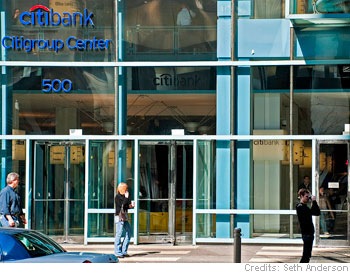 On Monday, Citigroup (C) received permission from its regulators to buy back the remaining $20 billion in preferred shares held by Treasury because of its investments under TARP. (Treasury invested $25 billion in October 2008 and another $20 billion November 2008; however, $25 billion worth of preferred shares were converted into common shares earlier this year, giving the government about a 34% ownership stake in the bank.) The stock then fell by 6%. What’s going on?
On Monday, Citigroup (C) received permission from its regulators to buy back the remaining $20 billion in preferred shares held by Treasury because of its investments under TARP. (Treasury invested $25 billion in October 2008 and another $20 billion November 2008; however, $25 billion worth of preferred shares were converted into common shares earlier this year, giving the government about a 34% ownership stake in the bank.) The stock then fell by 6%. What’s going on?
This is another example of a bank doing something stupid in order to say that it is no longer receiving TARP money, and probably more importantly so it can escape executive compensation restrictions. As Citigroup CEO Vikram Pandit himself said last October, TARP capital is really cheap (quoted in David Wessel, In Fed We Trust). Instead of paying an 8% interest rate* on $20 billion in preferred shares, Citigroup chose to issue $17 billion of new common shares while its share price is below $4/share. Citigroup’s cost of equity is certainly more than 8%, so it just increased its overall cost of capital. The stock price fell because existing shareholders are guessing that the dilution they suffered (because new shares were issued) will more than compensate for the fact that Citi no longer has to pay dividends to Treasury.
Paying back the TARP money also makes Citigroup weaker. That’s $20 billion less in cash it has to withstand any potential problems in its asset portfolio. Now, you can say that it compensated by issuing new equity. But those are two separate transactions; Citi could have issued the common shares whether or not it paid back its TARP money. Standing on its own, paying back TARP money is unequivocally bad for the balance sheet.
So this is bad for Citigroup shareholders and bad for Citigroup–except for the potentially important fact that Citi can now pay more money to its employees, which matters if you believe that pay is correlated with future performance (it doesn’t matter if it’s only correlated with past performance). So why are the regulators letting Citigroup do it? I think there are two reasons. The first is that they’re on a slippery slope. Once they let Bank of America (BAC) pay back its TARP money, they couldn’t say no to Citigroup without confirming what everyone has always believed but that the government has scrupulously avoided saying: that Citi really is in worse shape than the other banks. The second reason is that it enables the government to declare victory and put TARP behind it, which is certainly valuable for political reasons.
What about for the taxpayer? I may differ from some people here, but I actually think it’s good for the taxpayer. We are getting our money back. The risk that Citigroup will come back for a future bailout has gone up, which is bad; but I believe that if such a bailout ever happens, it will have to be on draconian terms–a government takeover in which management is fired, shareholders are wiped out, and the company is broken into pieces and sold off. I doubt that any administration will be able to engineer another Citigroup-friendly bailout in the future.
Of course, on the way out the door, Citigroup did get one parting gift to reduce the chances that it will have to come back: an Internal Revenue Service exemption worth $38 billion. Arguably 34% of that is the government dealing with itself (since it owns 34% of Citigroup), but if the Times is right that still leaves $25 billion (about $1/share) of subsidy to Citi’s other shareholders. $13 billion of the $38 billion counts as capital for regulatory purposes, so this enables Citi to boost its capital ratio by a full percentage point (Citi’s risk-weighted assets were around $1 trillion at the time of the stress tests).
Finally, the FDIC is keeping $5.4 billion of the $7 billion in preferred shares it got from Citigroup in exchange for guaranteeing about $300 billion of assets in November 2008. More on that later.
* The interest rate on the first $25 billion was 5%; the rate on the next $20 billion was 8%. After the preferred-to-common conversion, I don’t know which rate applies.


Leave a Reply